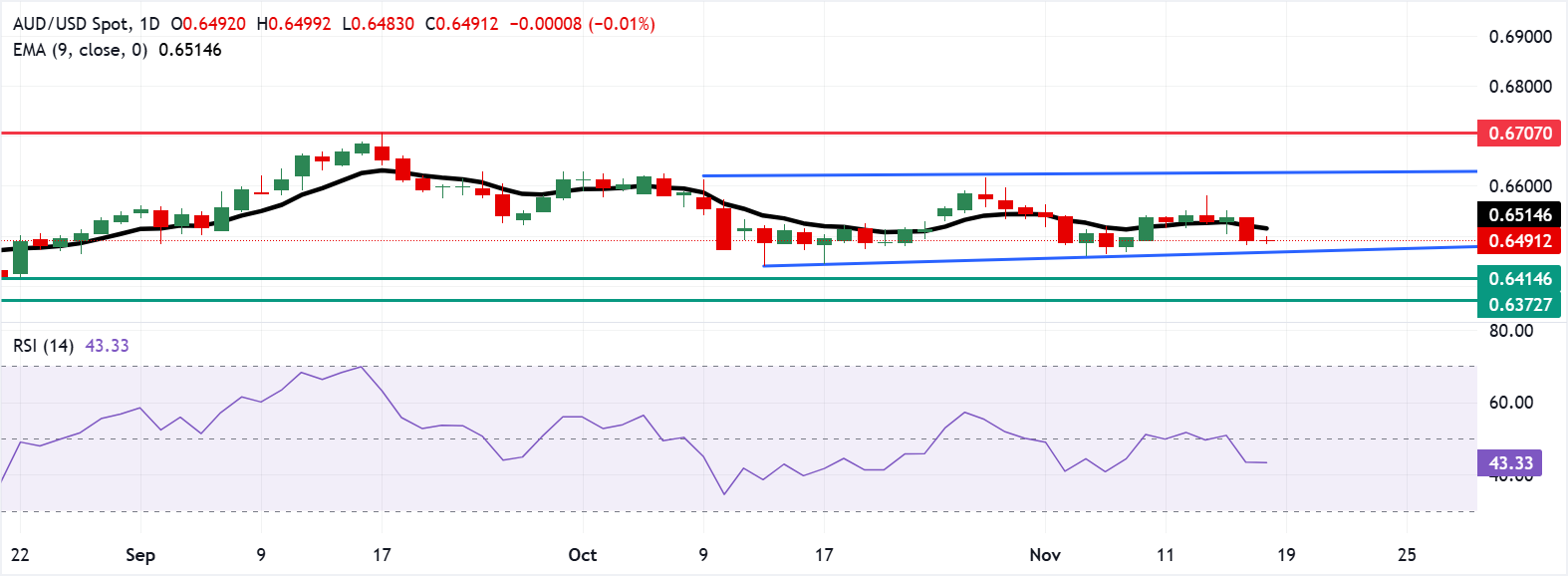Created
: 2025.11.18














![]() 2025.11.18 11:02
2025.11.18 11:02
The Australian Dollar (AUD) remains subdued against the US Dollar (USD) on Tuesday after registering losses in the previous session. The AUD/USD pair holds losses after the Reserve Bank of Australia (RBA) published the Minutes of its November monetary policy meeting.
The RBA Meeting Minutes showed that board members signalled a more balanced policy stance, adding that it could keep the cash rate unchanged for longer if incoming data proves stronger than expected.
However, the AUD may regain support as stronger domestic employment data reinforced expectations for a cautious stance from the Reserve Bank of Australia (RBA). As of the latest update on November 14, the ASX 30-Day Interbank Cash Rate Futures for December 2025 traded at 96.41, reflecting a 6% probability of a rate cut to 3.35% from 3.60% at the upcoming RBA Board meeting.
The AUD/USD pair is trading around 0.6490 on Tuesday. The analysis of the daily chart shows the pair consolidating within a rectangular range, reflecting sideways movement. The price moves below the nine-day Exponential Moving Average (EMA), suggesting that momentum is weakening.
On the downside, the primary support lies at the lower boundary of the rectangle around 0.6470, followed by the five-month low of 0.6414, which was recorded on August 21.
The AUD/USD pair may test the primary barrier at nine-day EMA of 0.6514. A break above this level would improve the short-term price momentum and lead the pair to reach the rectangle's upper boundary near 0.6630.

The table below shows the percentage change of Australian Dollar (AUD) against listed major currencies today. Australian Dollar was the weakest against the Swiss Franc.
| USD | EUR | GBP | JPY | CAD | AUD | NZD | CHF | |
|---|---|---|---|---|---|---|---|---|
| USD | -0.02% | 0.03% | -0.02% | 0.00% | 0.00% | -0.01% | -0.05% | |
| EUR | 0.02% | 0.05% | 0.00% | 0.02% | 0.03% | 0.00% | -0.03% | |
| GBP | -0.03% | -0.05% | -0.04% | -0.03% | -0.02% | -0.04% | -0.08% | |
| JPY | 0.02% | 0.00% | 0.04% | 0.02% | 0.02% | -0.01% | -0.04% | |
| CAD | -0.00% | -0.02% | 0.03% | -0.02% | 0.00% | -0.02% | -0.05% | |
| AUD | -0.01% | -0.03% | 0.02% | -0.02% | -0.01% | -0.03% | -0.06% | |
| NZD | 0.01% | -0.01% | 0.04% | 0.01% | 0.02% | 0.03% | -0.04% | |
| CHF | 0.05% | 0.03% | 0.08% | 0.04% | 0.05% | 0.06% | 0.04% |
The heat map shows percentage changes of major currencies against each other. The base currency is picked from the left column, while the quote currency is picked from the top row. For example, if you pick the Australian Dollar from the left column and move along the horizontal line to the US Dollar, the percentage change displayed in the box will represent AUD (base)/USD (quote).
One of the most significant factors for the Australian Dollar (AUD) is the level of interest rates set by the Reserve Bank of Australia (RBA). Because Australia is a resource-rich country another key driver is the price of its biggest export, Iron Ore. The health of the Chinese economy, its largest trading partner, is a factor, as well as inflation in Australia, its growth rate and Trade Balance. Market sentiment - whether investors are taking on more risky assets (risk-on) or seeking safe-havens (risk-off) - is also a factor, with risk-on positive for AUD.
The Reserve Bank of Australia (RBA) influences the Australian Dollar (AUD) by setting the level of interest rates that Australian banks can lend to each other. This influences the level of interest rates in the economy as a whole. The main goal of the RBA is to maintain a stable inflation rate of 2-3% by adjusting interest rates up or down. Relatively high interest rates compared to other major central banks support the AUD, and the opposite for relatively low. The RBA can also use quantitative easing and tightening to influence credit conditions, with the former AUD-negative and the latter AUD-positive.
China is Australia's largest trading partner so the health of the Chinese economy is a major influence on the value of the Australian Dollar (AUD). When the Chinese economy is doing well it purchases more raw materials, goods and services from Australia, lifting demand for the AUD, and pushing up its value. The opposite is the case when the Chinese economy is not growing as fast as expected. Positive or negative surprises in Chinese growth data, therefore, often have a direct impact on the Australian Dollar and its pairs.
Iron Ore is Australia's largest export, accounting for $118 billion a year according to data from 2021, with China as its primary destination. The price of Iron Ore, therefore, can be a driver of the Australian Dollar. Generally, if the price of Iron Ore rises, AUD also goes up, as aggregate demand for the currency increases. The opposite is the case if the price of Iron Ore falls. Higher Iron Ore prices also tend to result in a greater likelihood of a positive Trade Balance for Australia, which is also positive of the AUD.
The Trade Balance, which is the difference between what a country earns from its exports versus what it pays for its imports, is another factor that can influence the value of the Australian Dollar. If Australia produces highly sought after exports, then its currency will gain in value purely from the surplus demand created from foreign buyers seeking to purchase its exports versus what it spends to purchase imports. Therefore, a positive net Trade Balance strengthens the AUD, with the opposite effect if the Trade Balance is negative.
![]()
Created
: 2025.11.18
![]()
Last updated
: 2025.11.18

FXStreet is a forex information website, delivering market analysis and news articles 24/7.
It features a number of articles contributed by well-known analysts, in addition to the ones by its editorial team.
Founded in 2000 by Francesc Riverola, a Spanish economist, it has grown to become a world-renowned information website.
We hope you find this article useful. Any comments or suggestions will be greatly appreciated.
We are also looking for writers with extensive experience in forex and crypto to join us.
please contact us at [email protected].
Disclaimer:
All information and content provided on this website is provided for informational purposes only and is not intended to solicit any investment. Although all efforts are made in order to ensure that the information is correct, no guarantee is provided for the accuracy of any content on this website. Any decision made shall be the responsibility of the investor and Myforex does not take any responsibility whatsoever regarding the use of any information provided herein.
The content provided on this website belongs to Myforex and, where stated, the relevant licensors. All rights are reserved by Myforex and the relevant licensors, and no content of this website, whether in full or in part, shall be copied or displayed elsewhere without the explicit written permission of the relevant copyright holder. If you wish to use any part of the content provided on this website, please ensure that you contact Myforex.
Myforex uses cookies to improve the convenience and functionality of this website. This website may include cookies not only by us but also by third parties (advertisers, log analysts, etc.) for the purpose of tracking the activities of users. Cookie policy